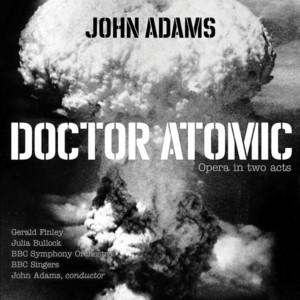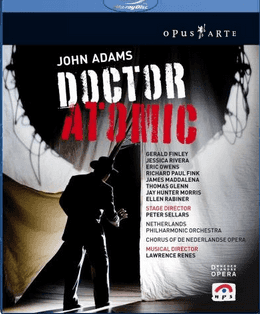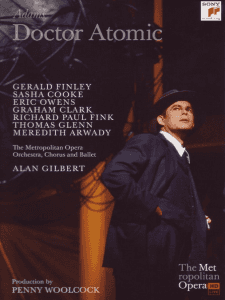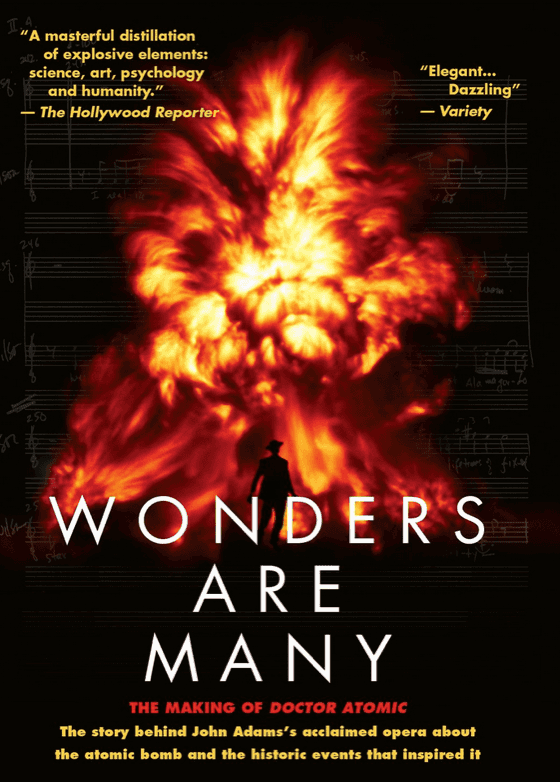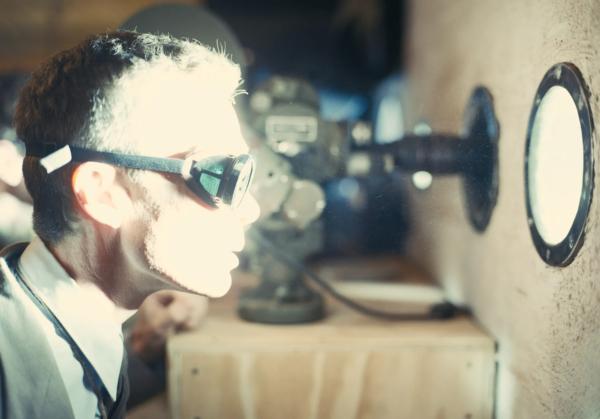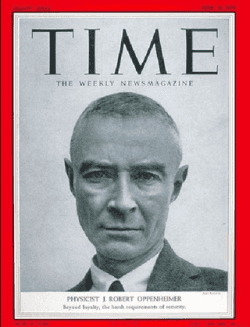
Doctor Atomic
Opera in Two Acts (2004-5)
“…the musical event of the year in America.”
– Anthony Tommasini, The New York Times
Commissioned by the San Francisco Opera

On Doctor Atomic
Doctor Atomic concerns the final hours leading up to the first atomic bomb explosion at the Alamagordo test site in New Mexico in July of 1945. The focal characters are the physicist and Manhattan Project director, Dr. J. Robert Oppenheimer; his wife Kitty; Edward Teller; and General Leslie Groves, the US Army commander of the project. The theme for this opera was suggested to Adams by Pamela Rosenberg, General Director of the San Franciso Opera.

The libretto of Doctor Atomic was created by Peter Sellars, drawing on original source material, including personal memoirs, recorded interviews, technical manuals of nuclear physics, declassified government documents, and the poetry of Muriel Rukeyser, an American poet and contemporary of Oppenheimer.
Synopsis
Act I Scene I
The Manhattan Project laboratory at Los Alamos, New Mexico. June, 1945.
Work on the atomic bomb approaches its culminating point. Physicists, engineers and US military personnel are all laboring under intense pressure from Washington in order to have the bomb tested and ready for use within the next month. J. Robert Oppenheimer- -“Oppie” to his friends–has brought the brightest minds in physics and engineering to the remote mesa in what was assumed to be a race against their German counterparts. But already Germany has surrendered, and many of the scientists are now beginning to question the necessity of its use on Japan.
General Leslie Groves, Army commander of the project, while aware of Oppenheimer’s vague but troubling past involvements with the Communist party, has up to now been able to persuade the government to look the other way because of the Oppenheimer’s great value to the program.
After an opening chorus describing the situation as of the end of June, Edward Teller approaches Oppenheimer in the lab. Teller’s obsession with his dream of a thermonuclear weapon, the “Super”, has caused difficulties in working with the other scientists. Team work is difficult for Teller, and Oppenheimer excuses him from group collaboration.
Teller shows Oppenheimer a letter he has just received from another physicist, the Hungarian Leo Szilard. Szilard is imploring all the scientists involved in atomic energy to take a moral stand on the bomb’s use by signing a letter to President Truman: “We alone are in a position to declare our stand.” Oppenheimer responds by admonishing Teller and all the others not to involve themselves in “political pronouncements.”
Robert Wilson, a young, idealistic physicist also working on the bomb is organizing a meeting in the lab to talk about the social and moral implications of the “Gadget” (code word for the bomb). Oppenheimer, well aware of Wilson’s socialist affinities, strongly objects to the idea of this meeting. “I might warn you–you could get in trouble if you had such a meeting.” Wilson too has a petition for the President that he hopes everyone will sign: “Atomic attacks on Japan cannot be justified until we make clear the terms of peace and give them a chance to surrender.”
Oppenheimer, who has just returned from Washington, describes the decision to bomb Japanese cities, including civilian targets. “We should seek to make a profound psychological impression on as many inhabitants as possible.” Wilson is outraged and accuses Oppenheimer of siding with the “Establishment.”
Act I Scene II
Oppenheimer and his wife, Kitty, are alone in their house at Los Alamos. It is a warm summer night, but Oppenheimer is preoccupied with reading reports. Kitty gently chides him: “Am I in your light?” Roused, Oppenheimer responds to her by quoting a rich, atmospheric stanza by one of his favorite poets, Baudelaire. For a brief moment they are both transported into the intoxicated climate of the poem.
Kitty is seized by a vision of the struggle of war and need for love: “A world is to be fought for, sung and built.”
Act I Scene III
The “Trinity” Test Site at Alamogordo, New Mexico. July 15, 1945
It is the night before the test of the first atomic bomb. Truman is already in Potsdam negotiating the spoils of Europe with Churchill and Stalin. The pressure on Oppenheimer and General Groves to achieve a successful test is overwhelming: the Americans want to have their nuclear weapon as a trump card to play agains the Russians.
The weather on the desert floor has changed abruptly. A freak summer electrical storm lashes the test site. The bomb, already partially armed for detonation and hoisted on a high tower, is in danger of being struck by lightning. Groves, beside himself with frustration and anxiety, berates the chief meteorolgist, Frank Hubbard, as if the storm were Hubbard’s fault. Hubbard warns the general that attempting a test in these conditions is extremely dangerous.
Captain Nolan, of the Army Medical Corps, impresses upon Groves the deadly toxic properties of plutonium that are only now beginning to be understood. An accident at the test site could render hundreds of military and scientific personnel fatally ill with painful radiation poisoning. Already panic is beginning to take hold, and several enlisted men have had to be removed under sedation.
Groves dismisses all staff in order to speak with Oppenheimer alone. “Oppie” gently humors Groves about the latter’s chronic weight problems, and the general confesses many failed attempts to control his diet.
Completely alone, Oppenheimer recalls a sonnet by John Donne, “Batter my heart, three-person’d God.” It is the poem that inspired him to name the test site, “Trinity.”
Act II Scene I
The Oppenheimer’s house in Los Alamos.
It is the night of July 15, 1945. The scientists and Army soldiers have left Los Alamos, and are now at the Alamagordo detonation area on the desert floor, more than a hundred miles away. Women have been prohibited from the test site.
Kitty and her Tewa Indian maid, Pasqualita, are sitting alone in the living room, drinking. Kitty scans the dial of her radio while Pasqualita occasionally checks on the Oppenheimer’s sleeping children. Kitty, in a long soliloquy, sings of the war, of death and of the resurrection of the spirit: “Now I say that the peace the spirit needs is peace, not lack of war, but fierce continual flame.”
Orchestral Interlude: Rain over the Sangre de Cristos Mountains.
Seven month-old Katherine Oppenheimer awakens, crying. Pasqualita takes the baby and comforts her by singing a lullaby and continues to watch the rain over the mountains.
Act II Scene II
The “Trinity” test site at Alamagordo, New Mexico. Midnight, July 16, 1945.
The plutonium bomb has been mounted on the detonation tower and all personnel have been cleared from the surrounding blast area.
Robert Wilson has to climb the tower one last time to attach a measuring instrument to the bomb. From the top of the tower he can feel the wind and rain buffet his face, and he sees flashes of lightning in the distance. Meteorologist Jack Hubbard is at the foot of the tower making wind velocity measurements ordered by Groves. Wilson confesses his extreme anxiety about being around the bomb in the middle of an electrical storm. To Hubbard a test in the middle of such weather is a “blunder of the first magnitude”, and he points out that the high winds could scatter lethal radioactive debris for miles.
While Wilson and Hubbard are at the tower, Groves, Oppenheimer and the others wait nervously at the Base Camp observation bunker for the storm to pass.
The scientists’ talk returns to a unsettling concern: whether or not the detonation might set off an uncontrolled chain reaction ending in the destruction of the entire earth’s atmosphere. Teller muses, “Might we not be setting off a chain reaction that will encircle the globe in a sea of fire?”
A rumor has it that Enrico Fermi, one of the team’s most respected scientists, has been taking bets on whether such a calamity might happen. Oppenheimer reminds them that they already have data confirming that such a result is not possible, but it hardly brightens the mood of gloom pervading the test site. With the rain still coming down, Groves disregards Hubbard’s warnings about the storm and orders all to prepare for the test shot at 5:30 AM.
Act II Scene III (Countdown Part I)
The final countdown begins at 5:10 AM.
Groves complains to his aide about the behavior of the scientists that has caused him endless security headaches: “This program has been plagued from the start by the presence of certain scientists of doubtful discretion and uncertain loyalty.”
Everyone waits, each absorbed in his own thoughts, the men in their bunkers at a distance of two miles from the explosion, Kitty and Pasqualita in the house back on the Los Alamos mesa.
Oppenheimer, whose normally thin frame has shrunken even further to 98 pounds, is in a state of extreme nervous exhaustion. He tries to calm himself by reading from a battered book of poetry he has brought along. Instead, he is beset by hallucinations.
Pasqualita, having drunken heavily during the night, has her own visions: “News came on the frost, ‘The dead are on the march!'”.
At Base Camp the men make a betting pool. Each tries to guess the yield of the bomb. Oppenheimer surprises everyone by his pessimistic prediction of a very low yield–“a fizzle”, Teller calls it. Even Groves is unable to conceal his depressed state and also guesses a low yield. Teller scoffs at their timidity and predicts a powerful explosion.
Oppenheimer suddenly is overcome by a terrifying vision of Vishnu described in the Bhagavad Gita: “At the sight of this, your Shape stupendous, full of mouths and eyes…terrible with fangs…when I see you, Vishnu…with your mouths agape and flame-eyes staring–all my peace is gone; my heart is troubled.”
Act II Scene IV (Countdown Part II)
Groves is concerned that Oppenheimer, “our high-strung director”, is going to have a nervous breakdown.
The storm breaks and the sky over Ground Zero suddenly clears. A warning rocket arches in the sky and a siren sounds. Everyone waits in a state of uncertainty. At Zero minus two minutes another warning rocket goes off but sputters out prematurely.
At Zero minus sixty seconds a different third rocket appears in the morning sky, signalling the final sixty-second countdown. Base Camp resembles an outpost of the dead: scientists and Army personnel are scattered about, hunkered in their shallow bunkers. There is no movement or whisper of activity, only the rhythmic voice of the countdown announcer over the loudspeaker. At Zero minus 45 seconds an engineer flips the switch for the automatic timer. The triggering circuits begin to fire in rapid precision.
“Zero minus one.” There is an eerie silence, and then the bomb goes off.
Featured Recording
Longtime Adams collaborator Peter Sellars created the libretto, drawing from original sources. The composer leads the BBC Singers and the BBC Symphony Orchestra in this recording, which features a cast led by Gerald Finley, who originated the role of Dr. J. Robert Oppenheimer.
BBC Singers, John Adams BBC Symphony Orchestra
Original Peter Sellars production on DVD
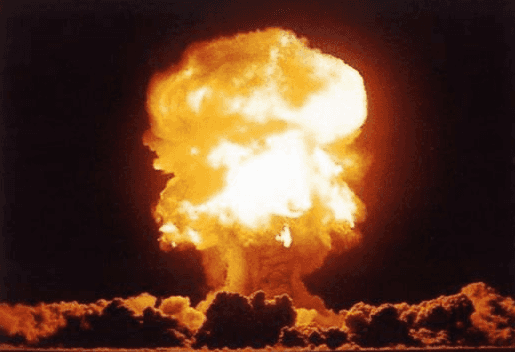
Staging & Cast
Music by John Adams.
Libretto by Peter Sellars based on original source material.
First performance October 1, 2005, San Francisco Opera.
Original staging by Peter Sellars
Music direction by Donald Runnicles
Sets by Adrienne Lobel; lighting by James F. Ingalls
Choreography by Lucinda Childs
Sound design by Mark Grey
Chorus direction by Ian Robertson
Cast
Gerald Finley (J. Robert Oppenheimer)
Kristine Jepson (Kitty Oppenheimer)
Richard Paul Fink (Edward Teller)
Eric Owens (General Groves)
Thomas Glenn (Robert Wilson)
Beth Clayton (Pasqualita)
James Maddelena (Frank Hubbard)
Jay Hunter Morris (Captain Nolan)
Score dedicated to Bob Hurwitz (dear friend, reader of history)
Documentary Making of Doctor Atomic
“Doctor Atomic Symphony,” based on orchestral music from the opera: first performance by the Saint Louis Symphony, David Robertson, conductor, March 16, 2007
Related Links
Staging Nuclear Dread in “Oppenheimer” and “Doctor Atomic”
How do you depict an event that has left a psychological scar—in some cases, physical scars—on almost everyone on the planet?
By Alex Ross
September 26, 2022
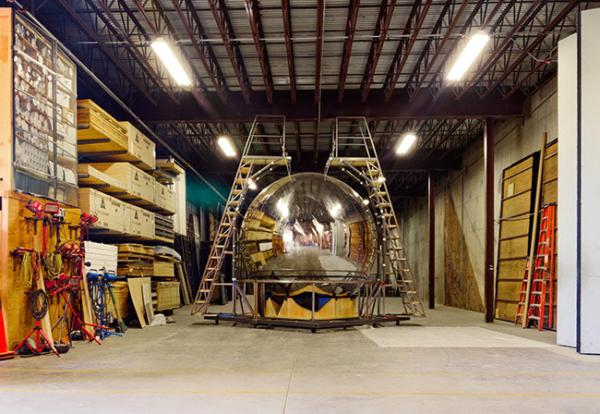
The test bomb in the Santa Fe production will not be an exact replica of the original, but a reflective sphere, representative of all nuclear weapons.Credit…Christopher Thompson for The New York Times
Bringing ‘Doctor Atomic’ to the Birthplace of the Bomb
By Michael Cooper
July 6, 2018
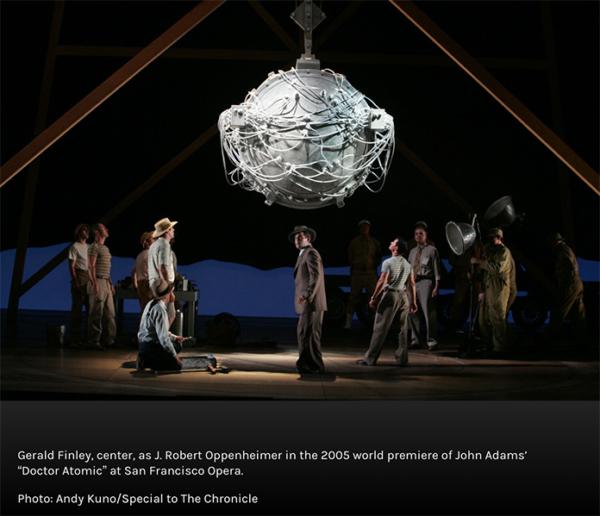
Gerald Finley, center, as J. Robert Oppenheimer in the 2005 world premiere of John Adams’ “Doctor Atomic” at San Francisco Opera. Photo: Andy Kuno/Special to The Chronicle
‘Oppenheimer’ film harks back to an operatic predecessor
By Joshua Kosman
August 8, 2023
Anatomy of a Scene
Doctor Atomic
By John Adams
